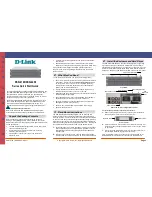
This choice is on the full Configuration/Setup Utility menu only.
v
System Security
Select this choice to view or change the security options.
This choice is on the full Configuration/Setup Utility menu only.
–
Power-on Password
Select this choice to set a power-on password. See “Power-on password” on
page 18 for more information.
–
Administrator Password
Attention:
If you set an administrator password and then forget it, there is
no way to change, override, or remove it. You must replace the I/O board, see
“Removing the I/O board assembly” on page 68 and “Replacing the I/O board
assembly” on page 69.
Select this choice to set or change an administrator password. An
administrator password is intended to be used by a system administrator; it
limits access to the full Configuration/Setup Utility menu. If an administrator
password is set, the full Configuration/Setup Utility menu is available only if
you type the administrator password at the password prompt. See
“Administrator password” on page 19 for more information.
This choice is on the Configuration/Setup Utility menu only if a Remote
Supervisor Adapter II SlimLine is installed.
–
TPM Setting
Select this choice to enable or disable the integrated TPM chip.
v
Start Options
Select this choice to view or change the start options. Changes in the start
options take effect when you restart the server.
This choice is on the full Configuration/Setup Utility menu only.
–
Startup Sequence Options
Select this choice to view the startup device sequence that is set for the
server.
You can specify whether the server starts with the keyboard number lock on
or off. You can enable the server to run without a diskette drive, monitor, or
keyboard.
The startup sequence specifies the order in which the server checks devices
to find a boot record. The server starts from the first boot record that it finds. If
the server has Wake on LAN
®
hardware and software and the operating
system supports Wake on LAN functions, you can specify a startup sequence
for the Wake on LAN functions.
If you enable the boot fail count, the BIOS default settings will be restored
after three consecutive failures to find a boot record.
You can enable a virus-detection test that checks for changes in the boot
record when the server starts.
You can enable the use of a USB legacy keyboard in a DOS or System Setup
environment. If a keyboard is detected, the USB legacy operation will be
disabled.
v
Advanced Setup
Select this choice to change settings for advanced hardware features.
Important:
The server might malfunction if these settings are incorrectly
configured. Follow the instructions on the screen carefully.
This choice is on the full Configuration/Setup Utility menu only.
16
IBM System x3755 Type 8877 and 7163: Problem Determination and Service Guide
Содержание 7163
Страница 1: ...IBM System x3755 Type 8877 and 7163 Problem Determination and Service Guide...
Страница 2: ......
Страница 3: ...IBM System x3755 Type 8877 and 7163 Problem Determination and Service Guide...
Страница 8: ...vi IBM System x3755 Type 8877 and 7163 Problem Determination and Service Guide...
Страница 40: ...24 IBM System x3755 Type 8877 and 7163 Problem Determination and Service Guide...
Страница 52: ...36 IBM System x3755 Type 8877 and 7163 Problem Determination and Service Guide...
Страница 88: ...72 IBM System x3755 Type 8877 and 7163 Problem Determination and Service Guide...
Страница 194: ...178 IBM System x3755 Type 8877 and 7163 Problem Determination and Service Guide...
Страница 204: ...188 IBM System x3755 Type 8877 and 7163 Problem Determination and Service Guide...
Страница 209: ......
Страница 210: ...Part Number 49Y0109 Printed in USA 1P P N 49Y0109...
















































